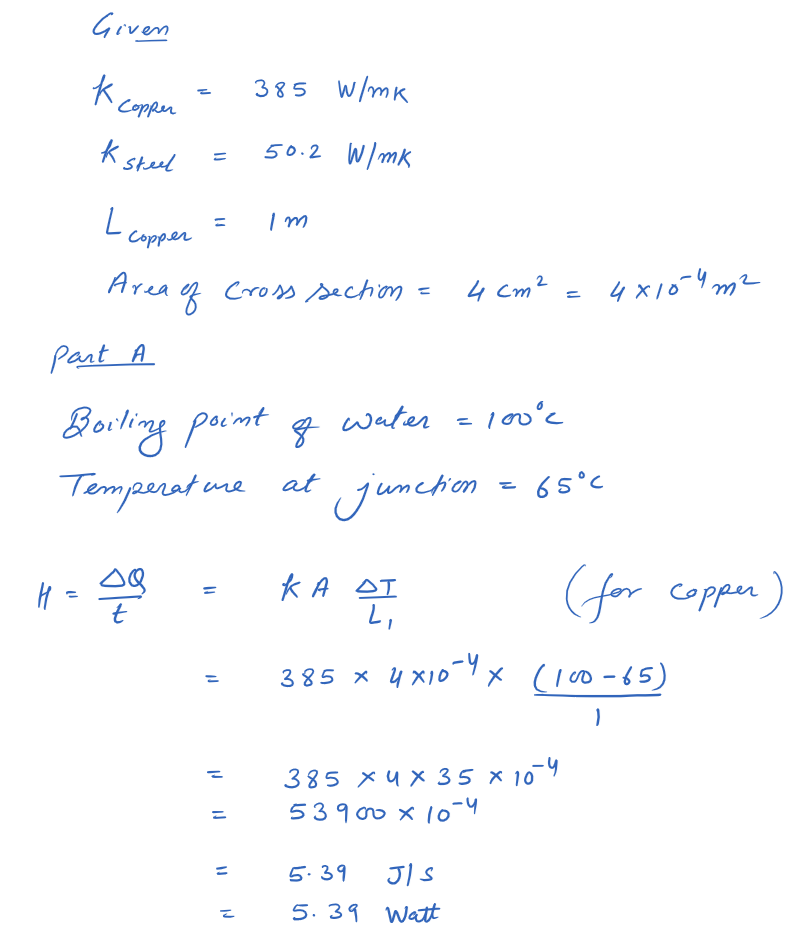A long rod, insulated to prevent heat loss along its sides, is in perfect thermal contact with boiling water (at atmospheric pressure) at one end and with an ice- water mixture at the other (Eigure 1). The rod consists of a 1.00 m section of copper (with one end in the boiling water) joined end-to-end to a length ₂ of steel (with one end in the ice water). Both sections of the rod have cross-sectional areas of 4.00 cm². The temperature of the copper-steel junction is 65.0°C after a steady state has been reached. Assume that the thermal conductivities of copper W and steel are given by copper = 385 and kistel = 50.2 mK mk Figure Coiling 65.0°C COPPER STEEL -1.00 m-L2- 0000 and water 1 of 1 > Part A How much heat per second (=) flows from the boiling water to the ice-water mixture? Express your answer in watts. ▸ View Available Hint(s) H = 5.39 W ✔ Correct Because the system is assumed to have reached a steady state, the heat flowing out of the boiling water must be equal to the heat flowing through the copper section of the rod. Part B Previous Answers What is the length of the steel section? Express your answer in meters. ▸ View Available Hint(s) Submit Η ΑΣΦΑ L₂-0.19 Previous Answers C X Incorrect; Try Again; 4 attempts remaining ?
A long rod, insulated to prevent heat loss along its sides, is in perfect thermal contact with boiling water (at atmospheric pressure) at one end and with an ice- water mixture at the other (Eigure 1). The rod consists of a 1.00 m section of copper (with one end in the boiling water) joined end-to-end to a length ₂ of steel (with one end in the ice water). Both sections of the rod have cross-sectional areas of 4.00 cm². The temperature of the copper-steel junction is 65.0°C after a steady state has been reached. Assume that the thermal conductivities of copper W and steel are given by copper = 385 and kistel = 50.2 mK mk Figure Coiling 65.0°C COPPER STEEL -1.00 m-L2- 0000 and water 1 of 1 > Part A How much heat per second (=) flows from the boiling water to the ice-water mixture? Express your answer in watts. ▸ View Available Hint(s) H = 5.39 W ✔ Correct Because the system is assumed to have reached a steady state, the heat flowing out of the boiling water must be equal to the heat flowing through the copper section of the rod. Part B Previous Answers What is the length of the steel section? Express your answer in meters. ▸ View Available Hint(s) Submit Η ΑΣΦΑ L₂-0.19 Previous Answers C X Incorrect; Try Again; 4 attempts remaining ?
College Physics
11th Edition
ISBN:9781305952300
Author:Raymond A. Serway, Chris Vuille
Publisher:Raymond A. Serway, Chris Vuille
Chapter1: Units, Trigonometry. And Vectors
Section: Chapter Questions
Problem 1CQ: Estimate the order of magnitude of the length, in meters, of each of the following; (a) a mouse, (b)...
Related questions
Question
100%

Transcribed Image Text:A long rod, insulated to prevent heat loss along its sides, is in perfect thermal
contact with boiling water (at atmospheric pressure) at one end and with an ice-
water mixture at the other (Figure 1). The rod consists of a 1.00 m section of
copper (with one end in the boiling water) joined end-to-end to a length 1₂ of
steel (with one end in the ice water). Both sections of the rod have cross-sectional
areas of 4.00 cm². The temperature of the copper-steel junction is 65.0°C after a
steady state has been reached. Assume that the thermal conductivities of copper
W
W
and steel are given by copper = 385
mrk and steel = 50.2
m-K
Figure
Boiling
water
200 00
65.0°C
COPPER STEEL
-1.00 mL200
1800
Ice and
water
1 of 1
Part A
How much heat per second H (=
Express your answer in watts.
► View Available Hint(s)
H= 5.39 W
Submit
Part B
Previous Answers
Correct
Because the system is assumed to have reached a steady state, the heat flowing out of the boiling water must be equal to the heat flowing through the copper section of the rod.
What is the length I of the steel section?
Express your answer in meters.
► View Available Hint(s)
ΠΙ ΑΣΦ
2)
) flows from the boiling water to the ice-water mixture?
L₂= 0.19
Submit Previous Answers
X Incorrect; Try Again; 4 attempts remaining
?
m
Expert Solution
Step 1

Trending now
This is a popular solution!
Step by step
Solved in 2 steps with 2 images

Knowledge Booster
Learn more about
Need a deep-dive on the concept behind this application? Look no further. Learn more about this topic, physics and related others by exploring similar questions and additional content below.Recommended textbooks for you

College Physics
Physics
ISBN:
9781305952300
Author:
Raymond A. Serway, Chris Vuille
Publisher:
Cengage Learning

University Physics (14th Edition)
Physics
ISBN:
9780133969290
Author:
Hugh D. Young, Roger A. Freedman
Publisher:
PEARSON

Introduction To Quantum Mechanics
Physics
ISBN:
9781107189638
Author:
Griffiths, David J., Schroeter, Darrell F.
Publisher:
Cambridge University Press

College Physics
Physics
ISBN:
9781305952300
Author:
Raymond A. Serway, Chris Vuille
Publisher:
Cengage Learning

University Physics (14th Edition)
Physics
ISBN:
9780133969290
Author:
Hugh D. Young, Roger A. Freedman
Publisher:
PEARSON

Introduction To Quantum Mechanics
Physics
ISBN:
9781107189638
Author:
Griffiths, David J., Schroeter, Darrell F.
Publisher:
Cambridge University Press

Physics for Scientists and Engineers
Physics
ISBN:
9781337553278
Author:
Raymond A. Serway, John W. Jewett
Publisher:
Cengage Learning

Lecture- Tutorials for Introductory Astronomy
Physics
ISBN:
9780321820464
Author:
Edward E. Prather, Tim P. Slater, Jeff P. Adams, Gina Brissenden
Publisher:
Addison-Wesley

College Physics: A Strategic Approach (4th Editio…
Physics
ISBN:
9780134609034
Author:
Randall D. Knight (Professor Emeritus), Brian Jones, Stuart Field
Publisher:
PEARSON